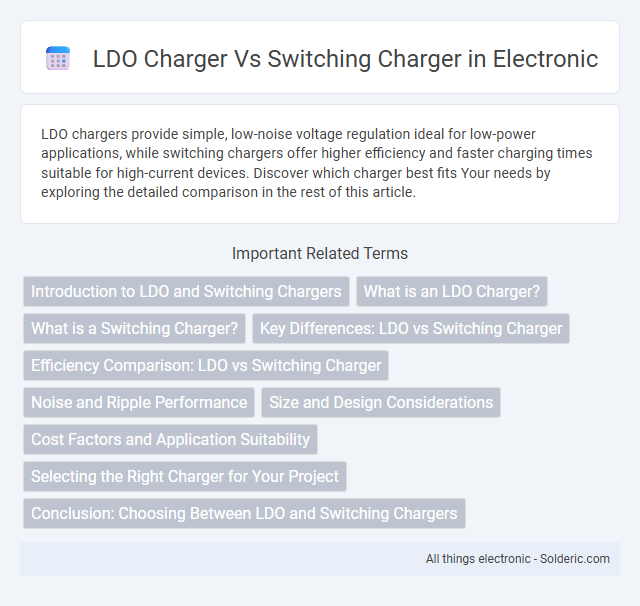LDO chargers provide simple, low-noise voltage regulation ideal for low-power applications, while switching chargers offer higher efficiency and faster charging times suitable for high-current devices. Discover which charger best fits Your needs by exploring the detailed comparison in the rest of this article.
Comparison Table
| Feature | LDO Charger | Switching Charger |
|---|---|---|
| Efficiency | Low (40-60%) | High (80-95%) |
| Heat Dissipation | High heat generation | Low heat generation |
| Complexity | Simple design | Complex circuitry |
| Cost | Lower cost | Higher cost |
| Size | Smaller PCB footprint | Larger PCB footprint |
| Noise | Minimal electrical noise | Potential electrical noise |
| Application | Low power, cost-sensitive devices | High power, efficiency-critical devices |
Introduction to LDO and Switching Chargers
LDO chargers use linear regulators to provide clean, stable voltage with minimal noise, making them ideal for low-power, sensitive devices. Switching chargers operate by rapidly switching components to efficiently convert power, offering higher efficiency and faster charging times for larger batteries. Your choice depends on the balance between efficiency needs and noise sensitivity in your application.
What is an LDO Charger?
An LDO charger is a Low Dropout Regulator charger that efficiently manages battery charging with minimal voltage difference between input and output, reducing heat generation and power loss. This type of charger is ideal for low-power applications where simplicity, low noise, and compact size are priorities. Your choice between an LDO charger and a switching charger depends on factors such as efficiency needs, thermal management, and system complexity.
What is a Switching Charger?
A switching charger uses high-frequency electronic switching to convert power efficiently, minimizing energy loss and heat generation compared to linear chargers. It operates by rapidly turning a transistor on and off, controlling voltage and current to optimize battery charging. This technology supports faster charging times and better energy efficiency, making it ideal for modern rechargeable battery applications.
Key Differences: LDO vs Switching Charger
LDO chargers regulate voltage by dissipating excess power as heat, resulting in simpler design and lower electromagnetic interference but lower efficiency, especially with large voltage drops. Switching chargers use a high-frequency switching regulator to convert power efficiently, minimizing heat dissipation and improving battery charging speed, though they are more complex and can generate electrical noise. The choice between LDO and switching chargers depends on factors like power efficiency requirements, thermal management, cost, and application constraints such as space and EMI sensitivity.
Efficiency Comparison: LDO vs Switching Charger
Switching chargers achieve higher efficiency, typically between 80% to 95%, by using high-frequency switching components to regulate voltage with minimal energy loss. LDO chargers maintain lower efficiency, often around 50% to 70%, due to their linear regulation method that dissipates excess voltage as heat. This efficiency advantage in switching chargers results in longer battery life and reduced thermal management requirements compared to LDO chargers.
Noise and Ripple Performance
LDO chargers exhibit superior noise and ripple performance due to their linear regulation method, resulting in lower electromagnetic interference (EMI) and cleaner output voltage, ideal for sensitive analog and RF circuits. In contrast, switching chargers, while more efficient and capable of handling higher power, typically generate higher noise and ripple because of their high-frequency switching operation, necessitating additional filtering components. Designers must weigh the trade-off between efficiency and noise performance when choosing between LDO and switching chargers for noise-sensitive applications.
Size and Design Considerations
LDO chargers feature simpler circuitry that results in smaller, more compact designs ideal for space-constrained applications. Switching chargers, while slightly larger due to inductors and additional components, offer greater efficiency and flexibility in power management. Your choice depends on the trade-off between minimizing size and optimizing energy efficiency for your specific device design.
Cost Factors and Application Suitability
LDO chargers offer lower cost and simpler design, making them suitable for applications with low power requirements and minimal space constraints. Switching chargers provide higher efficiency and better heat management, ideal for high-current, battery-powered devices where energy conservation is critical. Your choice depends on balancing budget limitations against performance needs and application-specific demands.
Selecting the Right Charger for Your Project
When selecting the right charger for your project, an LDO charger offers simplicity and low noise, ideal for applications requiring low power and minimal heat dissipation. Switching chargers provide higher efficiency and faster charging times, making them suitable for projects with larger batteries or limited power sources. Understanding your project's power demands and thermal constraints ensures you choose the charger that optimizes performance and battery longevity.
Conclusion: Choosing Between LDO and Switching Chargers
LDO chargers offer simplicity, low noise, and cost-effectiveness, making them ideal for low-power applications and sensitive analog circuits. Switching chargers provide higher efficiency and better heat management, which suits devices with larger batteries and faster charging needs. Your choice depends on balancing efficiency requirements, thermal constraints, and budget considerations to optimize device performance.
LDO charger vs Switching charger Infographic

 solderic.com
solderic.com